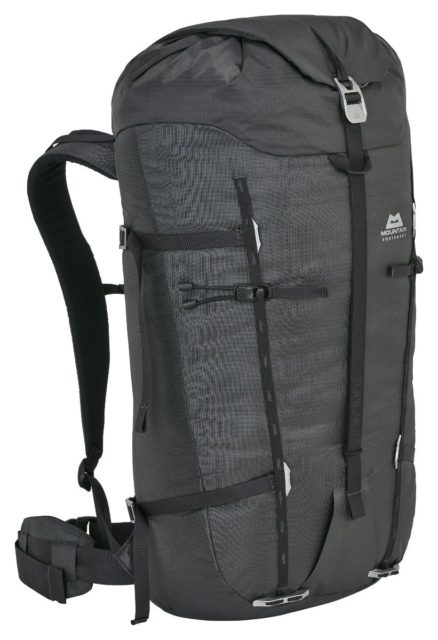
Mountain Equipment Tupilak 37+ Pack
Available Size: One Size (torso length of 47 cm / 19”)
Stated Weight: 780 g
Blister’s Measured Weight: 820 g
Stated Volume: 37 Liters Minimum (can be overstuffed)
Materials:
- Body: PACT™ 100 R2 double-ripstop with DWR and TPU coatings
- Side, Front, Back, and Bottom Panels: PACT™ 300 R2 double-ripstop with DWR and TPU coatings
Stated Features:
- PACT™ 300 & 100 R2 fabrics; durable, lightweight and water resistant
- On Demand Minimalism; all components removable
- Integrated cowl-lid closure for easy packing and weather protection
- Durable aluminium Grappler™ buckle
- Internal ‘floating’ accessories pocket; accessible from inside or outside of pack
- Internal weather-proof cowl with roll-top closure
- Side compression straps with aluminium Hammerhead™ toggles
- High Density EVA back panel
- High Density EVA shoulder straps
- 40mm webbing hipbelt with removable High Density EVA moulded hip-fins
- Dual axe toggles with integrated pick pocket
- Daisy Chain system and haul loops
- Supplied with Shockcord System
Price: $270
Test Locations: Northwest Montana Backcountry & Glacier National Park, MT; Frenchman Coulee, WA; Smith Rock, OR; Red Rock Canyon, NV
Reviewer: 5’ 8”, 200 lbs
Days Tested: 25
Intro
Mountain Equipment has been working on their alpine packs for a long time. And after three years, 35 prototypes, and eight fully custom components, they’ve finally released their Tupilak 30+, 37+, and 45+ packs. These packs are all designed to be minimal, durable, weather-resistant, and able to take you from the approach all the way to the top of your route. The Tupilak 37+ sits in a versatile spot in terms of volume, and here’s what Mountain Equipment says about it:
“Rewarding the minimalist focused alpinist with arguably our finest all-around pack. This durable, highly weather-resistant yet lightweight climbing and mountaineering pack is perfect for summer alpine and winter climbing on the steepest lines.”
I had a few questions going into this review. First, since this is an alpine-focused pack, how does it handle carrying all the necessary gear for climbing or ski touring, and then how well does it get out of the way when skis go on my feet or the rope is tied to my harness? Second, how well does the Tupilak 37+ perform when using it for activities beyond alpine climbing, such as ski touring and more casual crag climbing? And lastly, since there are now several options in the minimal, alpine pack category (e.g., Patagonia Ascensionist, Osprey Variant, etc.), how does the Tupilak 37+ distinguish itself?
Fit
The Tupilak 37+ isn’t offered in different sizes, doesn’t have any kind of sliding fit adjustment system, and comes standard with a 19” torso length. This has worked just fine for my 5’ 8” frame, but I’d recommend trying on the Tupilak 37+ before purchasing (especially if you’re on the tall or short end of the spectrum). For comparison, I use a size M/L for the Osprey Mutant 28 and Variant 37, and a S/M for the Patagonia Ascensionist 35.
For packs that I’ll be climbing in, I prefer to cinch up the shoulder straps and not use the hip belt while climbing so that the pack rides high on my back and out of the way of the back of my harness. But I also want to be able to lengthen the shoulder straps enough so that the hip belt hits my hips correctly when I’m off the wall and want to use the hip belt to help distribute the weight while hiking.
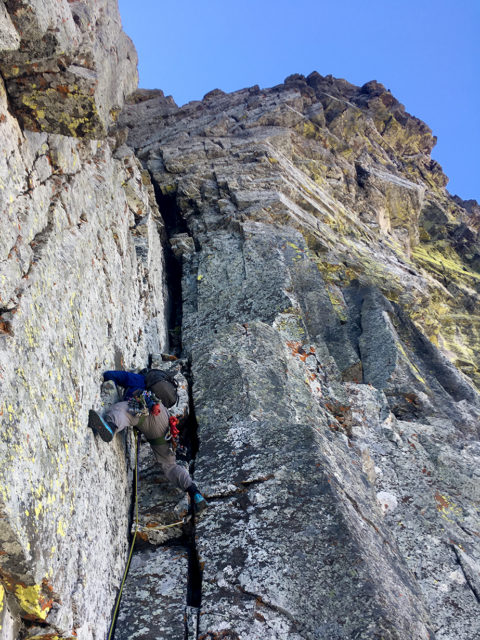
For me, the Tupilak 37’s torso length works perfectly for this “high when climbing, low when hiking” approach. The size S/M Ascensionist 35 doesn’t work quite as well because it feels a bit shorter than the Tupilak 37+ and as a result, the hip belt doesn’t do much in terms of distributing weight when I’m hiking with it. The Osprey Mutant 28 and Variant 37 feel like they sit low on my back regardless of activity. This makes the Osprey packs great for hiking, but also means they get in the way of my harness while climbing.
If you’ve used or seen the Patagonia Ascensionist packs, the “Hip Fins” on the Tupilak’s waist belt will look very familiar. The Tupilak’s hip fins are removable, they do move around a bit while skinning or hiking, and in the Tupilak 37’s case, they don’t have gear loops. (The Ascensionist 40L’s hip pads do include gear loops, while the updated Ascensionist 30L doesn’t have any hip pads.)
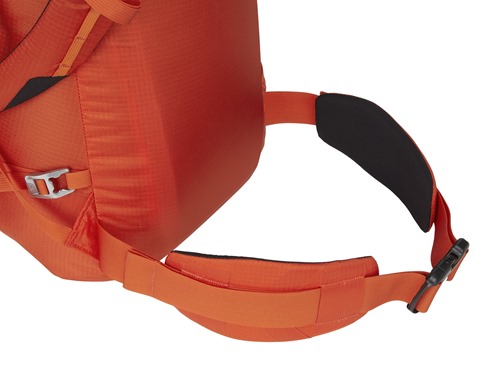
I’m personally fine with Mountain Equipment’s decision to ditch the gear loops; the only times I’ve found them useful have been while hauling gear across a glacier, and the Tupilak 37+ isn’t really meant for that (it’s more of a fast-and-light pack, rather than an expedition hauler). The Tupilak 37’s hip fins do a good job of balancing the minimalism required of an alpine pack while still offering more comfort when hauling a load compared to packs with simple webbing hip belts.
Fabric
Climbing packs seem to get abused a bit more than most other packs — they get dragged up chimneys, hauled up sandstone, and tossed in the dirt at the crag. And when it comes to dealing with this sort of abuse, the Tupilak 37+ stands out from the competition. The Tupilak 37’s fabric is light, very water resistant, and is still in excellent shape after all the thrutching I’ve been able to throw at it. I haven’t yet been able to tear any holes in the Tupilak 37+ after around 25 days of use, and given how light this pack is, that’s pretty impressive.

Both my Black Diamond Speed 22 and Ascensionist 35 have some significant tears / holes due to abrasive sandstone and, in the case of the Ascensionist 35, using it as a haul bag on Frigidaire Buttress in Red Rocks, NV. I haven’t yet hauled the Tupilak up such abrasive rock or used it for as many days as those other two packs, but based on my experience so far, I suspect it will hold up better.
The Tupilak 37+ has also done well in the snow, keeping my gear dry when I set it aside while digging pits or sitting on it during a lunch break. I think the Tupilak 37’s burlier and more water-resistant fabric is a big improvement over other packs in this class, and it definitely makes the Tupilak 37+ stand out.
Buckles, Straps, and Attachments
Another excellent feature on the Tupilak 37+ is its buckle system. The Tupilak 37+ uses metal hardware for everything but the harness and shock cording, and it features three different styles of custom aluminum buckles. The buckles all attach and detach to sewn webbing and are easy to move around or remove altogether from the pack (see photos below). And while these buckles might initially look gimmicky, I’ve never had them fail, move, slide, or come off when I didn’t want them to. I’m very impressed by this system.
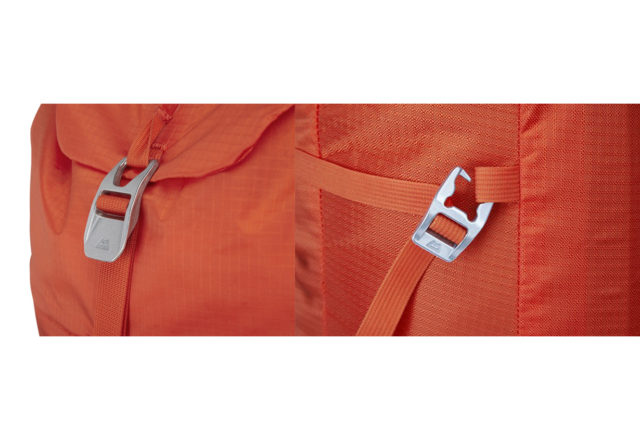
I also highly doubt that you’d be able to crush these aluminum buckles simply by stepping on them (which is not always the case with plastic options). I’m also confident that the Tupilak 37’s buckles will hold up better than plastic options when dragging them over rocks, smashing them into tight chimneys, etc. The Tupilak 37’s buckles have held their tension while carrying skis and effectively compress the bag to take it from an “all my junk hauler” to a “nimble, on-route pack.” I’ve been able to easily use the Tupilak 37’s buckles while wearing gloves, and the buckles don’t get plugged with snow. Again, I really like these buckles, and I wish every bag I owned used hardware like this.
One major difference between the Tupilak 37+ and Ascensionist 35L is that the Tupilak 37’s main strap, which cinches the lid down and also serves as a rope strap, is fixed to the lower part of the pack. This means that, depending on how full the pack is, there’s sometimes a ton of extra strap flapping around, and other times the strap is stretched to its very end. The Ascensionist packs’ main strap is removable and has an upper and lower anchor point which gives you more options for various load sizes.
The Tupilak 37+ includes a shockcord system for the daisy chains that run along the face of the pack. This removable shockcord system is designed to hold crampons, a puffy, or anything else you’d want to stuff under the cords. I haven’t used these shockcords since I always carry some ski straps in my essentials kit anyway, and the ski straps slot nicely through the daisy chains to cinch over crampons or a foam pad.
The Tupilak 37+ foregoes the traditional loop-style axe carry and instead features the increasingly popular t-anchor holders (see image below) and shockcord loops up top. A “pick pocket” sleeve on the face of the pack keeps the picks organized and mostly covered. The Tupilak 37’s axe carry system has worked fine with all of the modern, light axes and tools I use (e.g., Camp Corsa Nanotech and Black Diamond Viper). As long as the opening in the head of your axe is wide enough to fit a carabiner through it, the Tupilak 37’s t-anchors should work just fine.
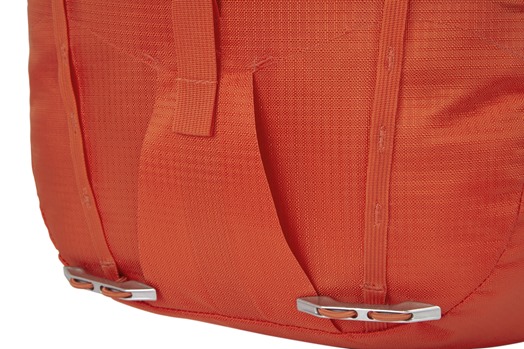
The last noteworthy thing about the Tupilak 37’s buckles and attachments is that many of them are removable, which means you can strip down the pack for an even lighter setup. With the Tupilak 37’s frame sheet, compression straps, and hip fins removed, it came in at 620 grams (200 grams lighter than with all those pieces attached to the pack).
Pockets and Dividers
The Tupilak 37+ takes a minimalist approach to dividing up the pack. Its upper accessory pocket “floats” inside the pack, has snaps to roll it up out of the way, and can be accessed from both the inside and outside of the pack, which is nice when the Tupilak 37+ is attached at a belay by its main haul loop. This accessory pocket tends to get squeezed by either the lid when closed, or by my stuff when packed to the brim, so that can limit its usefulness.
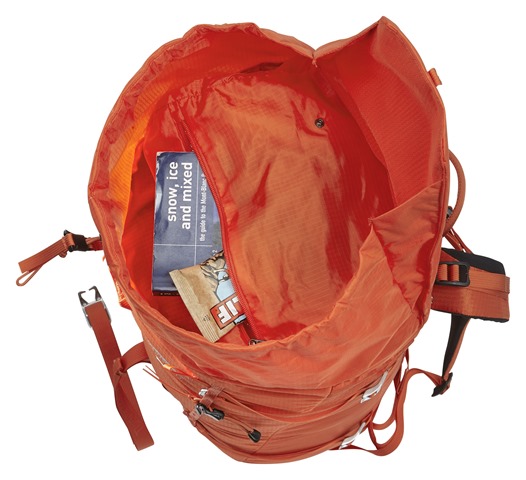
The Tupilak 37’s main compartment is one cavernous hole with an internal roll-top cowl attached around the rim about two-thirds of the way up the pack. Not only does this cowl help keep out weather and allow you to overstuff the pack with extra sandwiches, it can also be used as an internal divider to keep wet gloves and shells away from your dry layers. Smart.
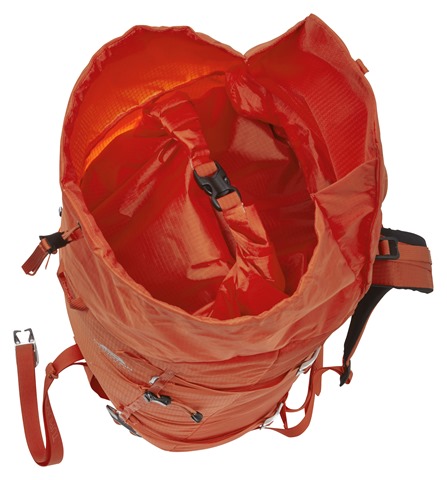
One seemingly missed opportunity with the Tupilak 37+ is that its lid has fabric on both the inside and outside, meaning that it could potentially be used as another pocket. But Mountain Equipment didn’t choose to take advantage of the lid as a pocket (something that Patagonia did do with their Ascensionist packs). A lid pocket would probably also suffer from the squeezing problem that affects the Tupilak 37’s accessory pocket, but it would still be nice to have a more accessible pocket there instead of just wasted space.
The Tupilak 37+ isn’t designed to accommodate a hydration bladder and hose. It has no internal bladder sleeve, no dedicated hose port, and no little strap to rig your hose on the shoulder strap. I don’t tend to use bladder / hose systems, but their usefulness while moving fast in the alpine during the summer is undeniable, as they leave you with no bottle to drop and offer hands-free drinking while belaying. You can make a bladder work in the Tupilak by routing the hose out of its accessory pocket’s external zipper, but this is not nearly as slick and streamlined as packs designed to work with bladders like the Osprey Mutant 28, and especially the Black Diamond Speed 22.
Carry and Use
Alpine packs like the Tupilak 37+ need to meet some pretty specific (and often contradictory) demands. First, they need to be able to efficiently get me, my personal gear, and a share of the group’s gear to the base of an objective. Then once I’m ready to climb or ski, I want a pack that can nearly disappear on my back for climbing, or remain stable while skiing down. And at the end of the day on the way home, the pack needs to carry weight well enough that I’m not cursing how much gear I brought with me.
I think the Tupilak 37+ hits all these markers. And it does great both in the winter and summer. The Ascensionist 35 tends to soak through easily, and the mesh back panel on the Osprey Mutant 28 picks up snow every time I set it down while ski touring. Neither are issues with the Tupilak 37+ — its fabric sheds water quite well.
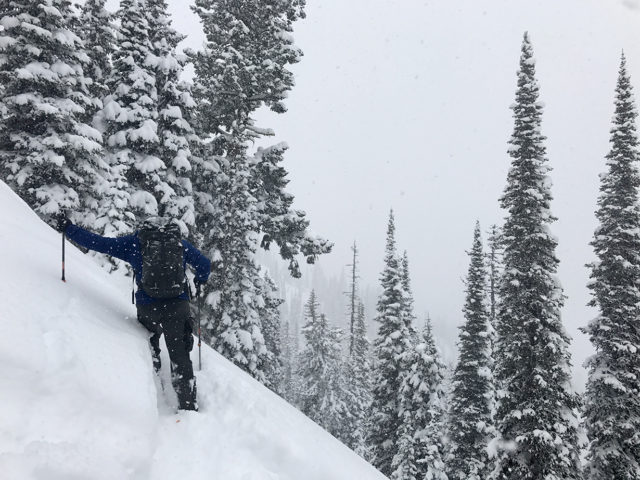
Like many climbing packs, the Tupilak 37+ doesn’t have a ventilated back panel, and the framesheet is removable and made of high-density EVA, rather than using metal or plastic stays. The lack of a ventilated backpanel has resulted in some sweaty approaches, but it keeps things simple and works much better in snow (since snow doesn’t stick to it). If you need an aerated backpanel, I’d recommend checking out some more fully featured options. Minimal alpine packs like the Tupilak 37+ and Ascensionist 35 aren’t designed with maximum breathability in mind.
While it’s designed for alpine climbing (and does quite well in that arena), I’ve also loved the Tupilak 37+ for ski touring and mountaineering. The stripped-back simplicity of the pack keeps the weight down and gives me most of the features I need in the backcountry. And with a dialed internal organization system (probe and saw on one side, shovel handle on the other, blade next to the face of the pack), I haven’t had an issue with the single main compartment. But if you prefer to have a separate compartment for your probe, shovel, etc., there are plenty of snow-specific packs that offer more organization options.
The Tupilak 37+ has also proved to be plenty durable as a cragging hauler (at least so far). It has room for my essentials, first aid kit, a layer, shoes, a double trad rack, sport draws, a harness, and some lunch. I’ll also often use the pack’s compressions straps to attach a 48 oz Nalgene and my belay flip flops on the way to the crag.
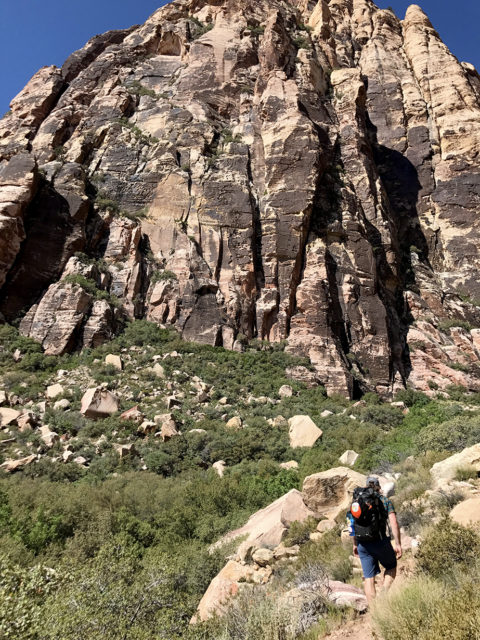
For me, the Tupilak 37+ offers plenty of support for carrying the heavy gear (e.g., skis, double racks, ropes, etc.) that are often required in the alpine. I think the Tupilak 37+ carries loads better than the Ascensionist 35, equal to the Mutant 28, and roughly 30% worse than the Variant 37 (the Variant 37 is easily my go-to climbing pack for carrying heavy loads).
Durability
With twenty-five days of use outside and two flights as checked luggage, the Tupilak 37+ looks a little dusty, but nearly brand new. I think I’m going to be able to use this pack for a long time, primarily as a result of its surprisingly burly fabric and metal buckles.
I’ll update this review if any durability issues arise in the future as I put more time in the Tupilak 37+.
Who’s It For?
I think folks who are looking for a light, minimal climbing pack on the upper end of the volume spectrum and who want to use it across a range of alpine activities will be psyched on the Tupilak 37+ because of its durability, weather resistance, and streamlined design. It carries loads well enough for taking gear to the crag or the top of the line, and then when it’s time to climb or ski, it does a pretty good job of staying out of the way.
The Tupilak 37+ can work as a lightweight hiking or backpacking bag, but the lack of a truly supportive hip belt and non-ventilated backpanel make it a sweaty and less supportive option for those activities. Also, the single-size fit means that it might not work for folks on the very ends of the height spectrum. It’s also worth noting that the Tupilak 37+ costs $270, which is very expensive compared to the Ascensionist 40L ($179) and Variant 37 ($180). So you’ll have to decide if the Tupilak 37’s performance is worth that bump in price.
Bottom Line
The Mountain Equipment Tupilak 37+ is a fantastic all-day climbing pack that also works great for other alpine activities like ski touring and ski mountaineering. Its design and features are minimal while still being very useful, and its fabric has so far proven to be more durable and water resistant than some other lightweight alpine packs. All of this has made the Tupilak 37+ my favorite all-day climbing pack, and the best one I’ve used.

It looks somewhat similar in terms of price and fabric to the Crux AK37. Worth comparing?
Any comparison to the Alpha FL series from Arc’teryx?